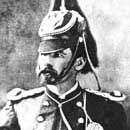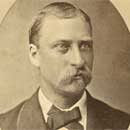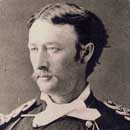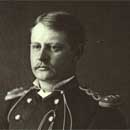|
||||||||||||
Bruce Brown's 100 Voices... Who Became the A look at the Seventh Cavalry chain of command
There are reasonable suggestions that Captain Custer temporarily served headquarters staff as aide-de-camp to brother George (George A. Custer), leaving 2d Lt. Henry Harrington as C Company commander (and the only officer with the company). Thus, possibly, the battalion consisted of a right wing with Companies I (Keogh, first in rank), E (Smith, third in rank), and C (Harrington, fifth in rank) and a left wing of F (Yates, second in rank) and L (Calhoun, fourth in rank). This apportionment is not likely, however, for tactics allowed a company to maintain its prescribed battalion position in the absence, usually brief, of its commander. Captain Custer, if with the command staff, was technically not absent. A headquarters staff (regiment), by the way, consisted of the regimental commander, his aide, an adjutant officer, the sergeant major, a trumpeter, and others. In the strictest sense, the battalion consisted of five companies and the staff.
The Seventh Cavalry chain of command when Custer fell was (left to tight) Myles Keogh, Thomas Yates, Thomas Custer, James Calhoun. Archaeology, History and Custer's Last Battle by Richard Allan Fox, Jr., University of Oklahoma Press 2000 p 140
This note by Richard Allan Fox, Jr. delineates the Seventh Cavalry chain of command after Custer was killed: Keogh, Yates, Thomas Custer, Smith and Calhoun. Thomas Custer was George Custer's brother, and Calhoun was his brother-in-law. Major Marcus Reno and Capt. Frederick Benteen, who commanded Custer's two wings after he split his command, ranked number two and number three in the overall chain of command, but they were not with Custer when he fell.
|
||||||||||||



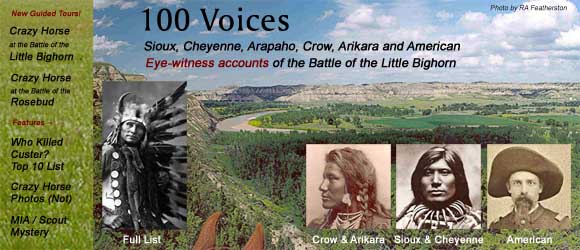
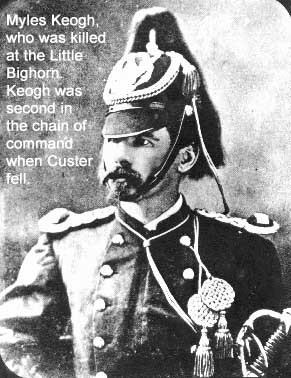 CAVALRY TACTICS instituted in 1874, as I have shown, prescribed wing composition on the basis of company commander seniority. The five companies that entered the Custer battle were C, E, F, 1, and L. Their respective commanders, with dates of rank and seniority, were Capt. Thomas Custer (December 2, 1875, third in rank), 1 st Lt. Algernon Smith (December 5, 1868, fourth in rank), Capt. George Yates (August 19, 1867, second in rank), Capt. Myles Keogh (July 28, 1866, first in rank) and 1st Lt. James Calhoun (January 9, 1871, fifth or last in rank). According to the tactical manual, therefore, the battalion should have been apportioned with Companies 1, C, and L in the right wing, Captain Keogh (I Company) commanding, and Companies F and E in a left wing commanded by Captain Yates (F Company): F, E, C, L, 1, with wing division between E and C.
CAVALRY TACTICS instituted in 1874, as I have shown, prescribed wing composition on the basis of company commander seniority. The five companies that entered the Custer battle were C, E, F, 1, and L. Their respective commanders, with dates of rank and seniority, were Capt. Thomas Custer (December 2, 1875, third in rank), 1 st Lt. Algernon Smith (December 5, 1868, fourth in rank), Capt. George Yates (August 19, 1867, second in rank), Capt. Myles Keogh (July 28, 1866, first in rank) and 1st Lt. James Calhoun (January 9, 1871, fifth or last in rank). According to the tactical manual, therefore, the battalion should have been apportioned with Companies 1, C, and L in the right wing, Captain Keogh (I Company) commanding, and Companies F and E in a left wing commanded by Captain Yates (F Company): F, E, C, L, 1, with wing division between E and C.